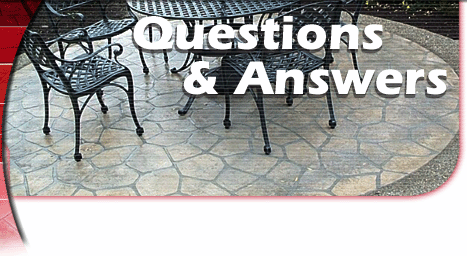




 |
|||||
|
|
|
|
|
|
|
|
|
|
 |
 |
||
|
|
|
||||
|
|
|
||||
|
|
|
||||
|
|
|
||||
|
|
|
||||
 |
 |
||||
| Frequently Asked Questions about Decorative Concrete. | |
| 1. What is Decorative Concrete? Decorative concrete is taking a plain surface and adding features to create an attractive surface. This is as simple as an interesting joint pattern to adding color, patterns, and texture to simulate stone or brick. |
|
| 2. What does decorative concrete cost?
When comparing decorative concrete to the product that it is simulating, i.e.: stone or brick pavers adhered to a concrete base, the cost is a very good value. When comparing decorative concrete to pavers set in a sand base, the cost is very competitive. The cost of decorative concrete is primarily driven by project, complexity, project quantity / size, and site access. |
|
| 3. Why should I use decorative concrete
in lieu of stone or brick pavers for my patio or walkway? The advantage of concrete is it is a very strong and durable product. Concrete can settle if the sub grade is poor, but if designed and constructed properly it will span the weak soil areas. The concrete area should be designed to allow it to move during freeze / thaw cycles. Should movement occur, the area will move as a mass with little effect on the surface of the area. The surface of the concrete is textured and colored at the time of its placement. This eliminates the need to return and apply the finish surface such as pavers or stone, therefore, reducing the cost of the project. Decorative treatments can be used with standard concrete surfaces. Together they become a unit resistance to differential settlement. When color hardener is used to color the concrete, the hardener almost doulbes the surface strength of the concrete. The advantage of brick or stone is they each have unique colors nearly inpossible to create with colored concrete. The disadvantages are they tend to move more over the years from ground movement caused from freeze thaw cycles and natural settlement. The grouted joints tend to open over time allowing water to penetrate and freeze, causing the tiles to come loose or the joints to deteiorate. If the joints are sand, weeds and grass love to grow in them. |
|
4. How are the color, patterns, and textures
appied? Coloring:
Patterns & Texture:
|
|
| 5. How large should my patio be?
When determining the size of your patio, ask yourself a few questions.
When the questions are answered, and the areas are plotted on to a sketch, the size of the patio will begin to develop. Keep in mind you need space to walk around the furniture. If the sidewalk is being constructed, leave ample room between the house and the walkway for plantings and lighting. Curve the walk if there is room to create the feel of a pathway. If the walkway is leading to the main entrance, make it wide enough for two people to walk side by side comfortably. Enlarge the area at the door or porch to create ample room to gather prior to entering or leaving the house. |
|
| 6. What shape should my patio be? Look at the design of the house. This may lead you a formal or casual free form style. The shape will probably be a personal preference. The patio many times becomes an outdoor room. With any room, the decorations play an important role with how the room feels when you are in it. Design areas for plantings, both in ground and potted.Leaving areas for planting beds between the patio and the walls of the house if the space exists. Sculpture and water features will ad beauty and serenity to the surroundings of your new room. Be sure to add a mix of low and high level lighting to the patio area to enjoy the area during the evening while outside as well as from the inside. |
|
| 7. You will have joints in the concrete
that may cross through the patterns? The finished product, although resembling a stone or brick paved surface, will have joints. The joints will be either hand tooled or cut with a saw. The joints are necessary to help control the random cracking that occurs in concrete as it changes from wet plastic material to a dry hard material. |
|
| 8. Will I have to maintain my new
decorative surfaced concrete? All decorative surfaces should be sealed occasionally to keep the surface looking new and to protect the surface from UV rays. The rays will cause the surface to fade. The frequency of the sealing and type of sealer used becomes personal. Sealers are sold as flat, semi-gloss, and gloss sheens. Additives to increase surface friction when the concrete is wet should be used with the semi-gloss or glossy sealers unless the surface of the concrete was textured to increase friction to minimize the risk of slipping or falling. |
|
| Copyright 2002-2003 G.R. Trumble
Construction Co., Inc. 280 Totten Lane - Florence KY - 859-283-9090 |